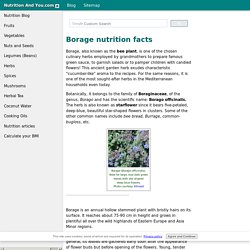

Yogainternational. There are two best friends in the ayurvedic pharmacy, ashwagandha and brahmi, who hold hands on the herbal playground as they calm and support your mind.

In my recent journey of reclaiming myself from grief, I rediscovered the sweet support of a daily abhyanga (self-oil massage) with these two herbs. Let me share why you might consider incorporating this herbal duo into your daily routine as well. The Benefits of Wormwood: A Harmful Organism Cleanser. Wormwood (Artemisia absinthium) is a bitter herb found in Eurasia, North Africa, and North America.

The plant has been used therapeutically since ancient times. Chamomile: More than calming. – Herbal Element. Tummy Tonic and Anxiety Release from our tea line both have this beautiful herb.

Benefits & Side Effects of Pine Needle Tea. The best benefits of pine needle tea include maximizing the immune system, improving vision, preventing respiratory infections, stimulating circulation, avoiding chronic disease, increasing cognitive performance, strengthening heart health and speeding healing.

Antidepressant Effects of Rosemary Extracts Associate With Anti-inflammatory Effect and Rebalance of Gut Microbiota. Introduction Major depressive disorder (MDD) is a severe mental sickness (Lemogne et al., 2013) featured by loss of interest, disturbed sleep, lack of energy, and suicidality, which gives rise to the highest ratio of worldwide burden according to mental disorders (Hou et al., 2016).

MDD has been strongly associated with gut microbiome diversity (Winter et al., 2018) and gut microbiota composition (Zheng et al., 2016). Previous research has established Lactobacillus helveticus NS8 plays an anti-depressant role in rats subjected to CRS depression and this effect is rooted from the microbiota-gut-brain axis (Liang et al., 2015). Depression affects serum cytokines alterations, including interleukin-1β (IL-1β), IL-6, and IL-8 levels, and leads to inflammatory processes (Kim et al., 2018).
Despite the consequences following depression are serious, effective antidepressant drugs are limited. Materials and Methods. Rosemary, the Free Radical Scavenger. Rosemary is a rich source of antioxidants and anti-inflammatory compounds that have been shown to protect against free radical damage in the brain.

Historically associated with improved memory, it has also been found to inhibit the formation of amyloid beta proteins characteristic of Alzheimer’s disease. Antioxidant A powerful antioxidant, rosemary helps preserve lipid (fat) membranes, which comprise 60% of the brain. Numerous studies have demonstrated that rosemary compounds activate the Nrf2 cell defense pathway, which releases an array of anti-oxidizing and detoxification enzymes that protect neurons from oxidative cell death. Research now clearly outlines a direct association between free radical damage and neuron death in Alzheimer’s disease, especially in brain regions with accumulations of beta-amyloid. Anti-Inflammatory Rosemary’s ability to upregulate the brain’s cellular antioxidant defenses is in turn responsible for its potent anti-inflammatory effects. Beta-Amyloid. Sweet Gum Tree - Eat The Weeds and other things, too. Dried Sweet Gum Fruit The Sweet Gum tree is the sand spur of the forest.

You painfully find them with your feet. The vicious seed pods have impaled many a forager and has done much to ruin the Sweet Gum’s reputation. Natural Health Guide. Learning to Love the Redbud Tree, One of Nature’s Great Gifts. Eastern Red Bud: Pea Pods Tree - Eat The Weeds and other things, too. Eastern Red Bud Blossoms It’s one of those trees that if you don’t see it at the right time you’re not looking for it the rest of the year.

I had gone past it perhaps four or five dozen times over a couple of seasons, but never in spring. But one day the blossom caught my eye. I knew what it was I just hadn’t seen it there before. Eastern Redbud trees are native across much of the United States and Canada, basically east of the Rockies. Red Bud’s Edible Pods Native Americans ate redbud flowers raw or cooked as well as the young pods and seeds raw or cooked. 7 Amazing Health Benefits of Birch Leaf. Top 8 Benefits of Bay Leaves. The most impressive health benefits of bay leaves include their probable anti-cancer properties, ability to detoxify the body and protect it from bacterial infections, slow the aging process, speed wound healing, and manage diabetes.
It also helps improve heart health, reduce inflammation, alleviate respiratory issues, and optimize digestion. What are Bay Leaves? There are many types of plants whose leaves are referred to as “bay leaves”, but the true bay leaf is scientifically known as Laurus nobilis, and this is the nutrient-rich variety that is discussed in the article. Many other leaves have a similar appearance and aroma like true bay leaves, but not the same nutrient content. This plant is a small tree native to the Mediterranean region. The uses of bay leaves include grinding the leaves into a spice to flavor soups and stews, but they are most commonly added in their whole form as a flavoring for certain Italian dishes and are then removed or used as a garnish. Improve Digestion. Borage (starflower) herb nutrition facts and health benefits.
Selection and storage Borage should be fresh for use in salads and cooking.

While buying from the markets look for fresh herb leaves with stout succulent stem and delicate cucumber flavor that can be appreciated from a short distance. Like in other greens such as spinach, borage can stay fresh only for a few hours and loses its flavor rather sooner. Unlike in other herbs like oregano, where dry herbs (leaves) and powder can be added to cuisine, dried borage leaves are out of flavor and therefore, avoided. Avoid sunken, yellow or dried leaves as they are out of flavor and taste. Calendula: The Anti-Inflammatory, Antiviral Healing Herb- Dr. Axe. It’s easily harvested and extracted and looks beautiful whether the flowers are in a pot or steeping in a large glass jar.

It can be made into a cream, oil, gel, compress, tincture or tea; used in a bath or facial steam; eaten in salads and stews; whipped into toothpastes or mixed into mouthwashes; and is gentle enough for babies and the elderly! What am I talking about? Horsetail: find out the 5 health benefits of this plant. The horsetail (Equisetum arvense L.) traditionally considered a medicinal plant with many properties for our health.
This plant is very appreciated for being one of the best natural diuretics that exist. Also highly valued for the positive benefits for the kidneys, slimming, depurative and detoxifying. Although it is a plant that grows in abundance in the clay soils of the humid regions of the northern hemisphere, at the moment it can be found in the whole planet, mainly, on the banks of the rivers and streams and in the surroundings of grasslands. But, in addition to its cleansing properties, horsetail is also known for its aesthetic and regenerative properties, as it helps to renew cell tissues, giving a better look to our skin and making it look more beautiful.
The sterile stems of the plant are harvested during the summer season and allowed to dry in the shade, eliminating discolored parts. 1. 2. 3. What Is Licorice Root Good For? By Dr. Mercola The scientific name for licorice root, Glycyrrhiza, comes from "glukos" (sweet) and "riza" (root). This "sweet root" contains glycyrrhizin, a compound that can be up to 50 times sweeter than sugar.
So it's not surprising that when many people think of licorice, they think of the confectionery by the same the name. However, licorice is a perennial herb native to the Mediterranean that's been prized for its medicinal properties for centuries. It was valued in ancient Arabia for treating coughs, while in ancient Greece it was also used for coughs along with asthma. Fenugreek. Rosemary facts. The Therapeutic Potential of Rosemary (Rosmarinus officinalis) Diterpenes for Alzheimer's Disease.